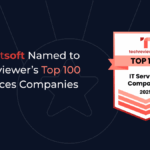Cybersecurity should be a top priority for organizations of all sizes. With the increasing frequency and sophistication of cyber threats, it’s essential to have robust defenses in place to protect sensitive data and maintain business continuity. In this article, we’ll explore the nine bare minimum cybersecurity practices that every organization should implement to stay protected against cyber threats.
Bare Minimum Cybersecurity Practices
- Multi-Factor Authentication (MFA): Implementing MFA adds an extra layer of security by requiring users to provide multiple forms of verification before accessing accounts or systems. This significantly reduces the risk of unauthorized access, even if passwords are compromised.
Watch our video on the fundamentals of Multi-Factor Authentication!
- Endpoint Detection: Endpoint detection and response (EDR) solutions monitor endpoints such as laptops, desktops, and mobile devices for suspicious activity or signs of compromise. This proactive approach helps organizations detect and respond to threats before they can cause significant damage.
Discover how Endpoint Detection and Response (EDR) can help your organization monitor and respond to threats effectively.
- Complex Passwords: Enforcing complex password policies ensures that passwords are strong and resistant to brute-force attacks. Require employees to use a combination of uppercase and lowercase letters, numbers, and special characters, and regularly remind them to update their passwords.
Check out our video on crafting strong and secure passwords!
- IT Policies: Establish comprehensive IT policies that outline security protocols, acceptable use guidelines, and procedures for handling sensitive information. Ensure that all employees are familiar with these policies and regularly update them to address emerging threats and compliance requirements.
Discover the IT Policies that Every Organization Needs
- Security Awareness Training: Human error remains one of the leading causes of data breaches, making security awareness training essential for all employees. Provide regular training sessions that cover topics such as phishing awareness, social engineering tactics, and best practices for data protection.
Discover the secrets to fortifying your human firewall
- No End-of-Life Equipment: Outdated or end-of-life equipment is more vulnerable to cyber threats due to the lack of security updates and patches. Ensure that all hardware and software are regularly updated and retire any outdated equipment to minimize security risks.
Learn why it’s Absolutely Essential to Keep Your Tech Updated
- Limit Admin Access: Restrict administrative privileges to only those employees who require them to perform their job duties. Limiting admin access reduces the risk of unauthorized changes to critical systems and helps prevent insider threats.
- Review IT Policies Regularly: Regularly review and update IT policies to reflect changes in technology, regulations, and cybersecurity best practices. Solicit feedback from employees and stakeholders to ensure that policies remain relevant and effective.
Watch our on-demand webinar for expert insights on How to Create a Successful Cybersecurity Policy
- Have a DR Plan/Critical Response Plan: Develop a comprehensive disaster recovery (DR) plan and critical response plan to minimize the impact of cyber incidents on your organization. Regularly test and update these plans to ensure that they remain effective in the event of a security breach or other emergency.
Explore the Various Types of Disasters to Include in Your Disaster Recovery Plan
Wrapping Up
Implementing these nine cybersecurity practices is essential for safeguarding your organization against cyber threats. By prioritizing security measures such as MFA, endpoint detection, and regular security awareness training, you can significantly reduce the risk of data breaches and protect your organization’s sensitive information and reputation. Remember, cybersecurity is an ongoing effort that requires continuous vigilance and adaptation to evolving threats.
Contact us to learn more about creating a strong cybersecurity posture for your organization.
Source link











